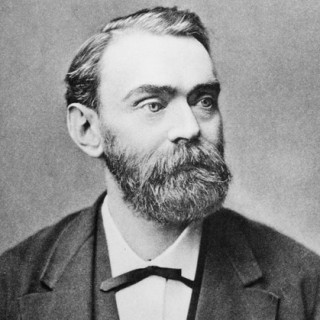Alfred Nobel (1801–1872)

Nobel was the third son of Immanuel Nobel (1801-1872) and Andriette Ahlsell Nobel (1805-1889). Born in Stockholm on October 21, 1833, he went with his family in 1842 to St. Petersburg, where his father (who had invented modern plywood) started a “torpedo” works. Alfred studied chemistry with Professor Nikolay Nikolaevich Zinin. In 1859, the factory was left to the care of the second son, Ludvig Nobel (1831-1888), who greatly enlarged it. Alfred, returning to Sweden with his father after the bankruptcy of their family business, devoted himself to the study of explosives, and especially to the safe manufacture and use of nitroglycerine (discovered in 1847 by Ascanio Sobrero, one of his fellow students under Théophile-Jules Pelouze at the University of Torino). Several explosions occurred at their family-owned factory in Heleneborg; one disastrous one killed Alfred’s younger brother Emil and several other workers in 1864.
Nobel found that when nitroglycerin was incorporated in an absorbent inert substance like kieselguhr (diatomaceous earth) it became safer and more convenient to handle, and this mixture he patented in 1867 as dynamite. Nobel demonstrated his explosive for the first time that year, at a quarry in Redhill, Surrey, England.
Nobel later on combined nitroglycerin with another explosive, gun-cotton, and obtained a transparent, jelly-like substance, which was a more powerful explosive than dynamite. Gelignite, or blasting gelatin as it was branded, was patented in 1876, and was followed by a host of similar combinations, modified by the addition of potassium nitrate and various other substances.
The foundations of the Nobel Prize were laid in 1895 when Alfred Nobel wrote his last will, leaving much of his wealth for its establishment. Since 1901, the prize has honored men and women for outstanding achievements in physics, chemistry, medicine, literature, and for work in peace.
In 1876 Bertha von Suttner became Alfred Nobel’s secretary but after only a brief stay, left and married Baron Arthur Gundaccar von Suttner. Though her personal contact with Alfred Nobel had been brief, she corresponded with him until his death in 1896, and it is believed that she was a major influence in his decision to include a peace prize among those prizes provided in his will, which she won in 1905.
Nobel also wrote Nemesis, a prose tragedy in four acts about Beatrice Cenci, partly inspired by Percy Bysshe Shelley’s The Cenci, was printed while he was dying. The entire stock except for three copies was destroyed immediately after his death, being regarded as scandalous and blasphemous. The first surviving edition (bilingual Swedish-Esperanto) was published in Sweden in 2003. The play has been translated to Slovenian via the Esperanto version.
Alfred Nobel is buried in Norra begravningsplatsen in Stockholm.

